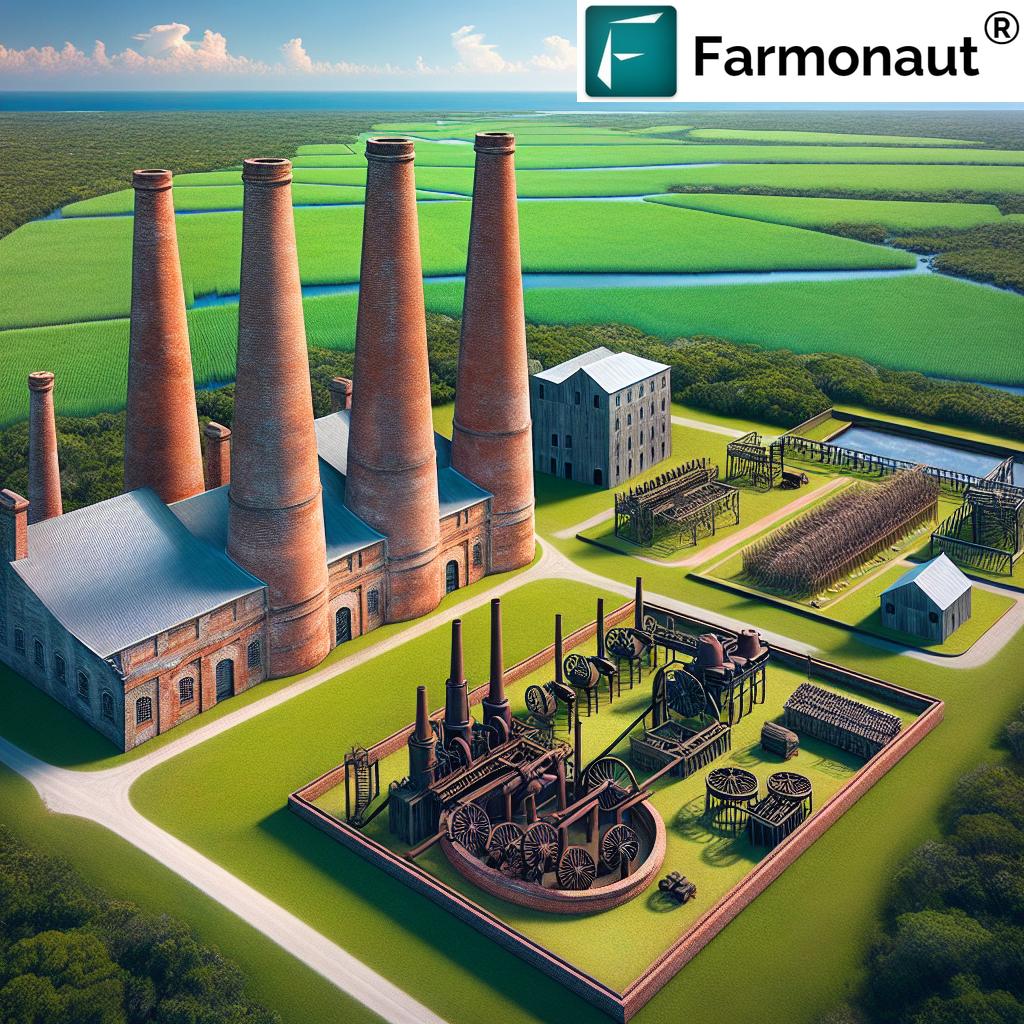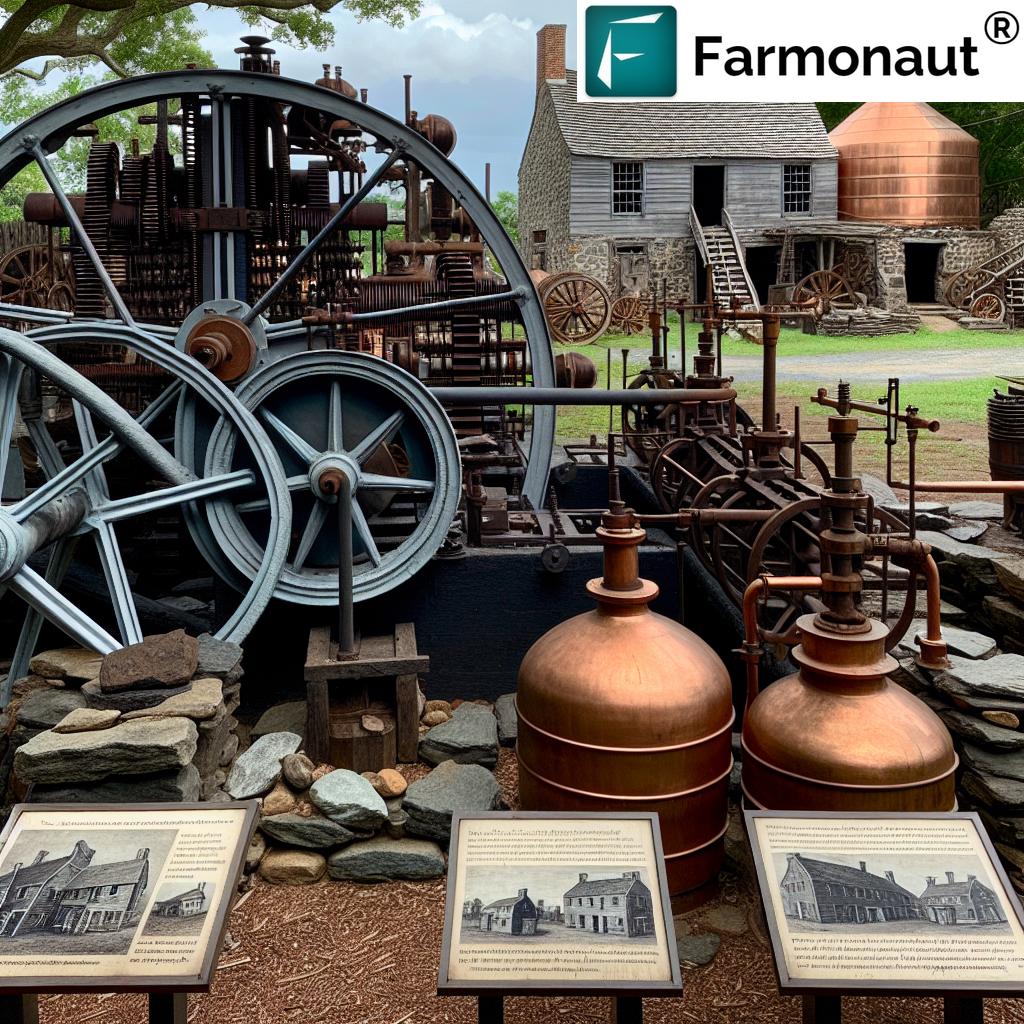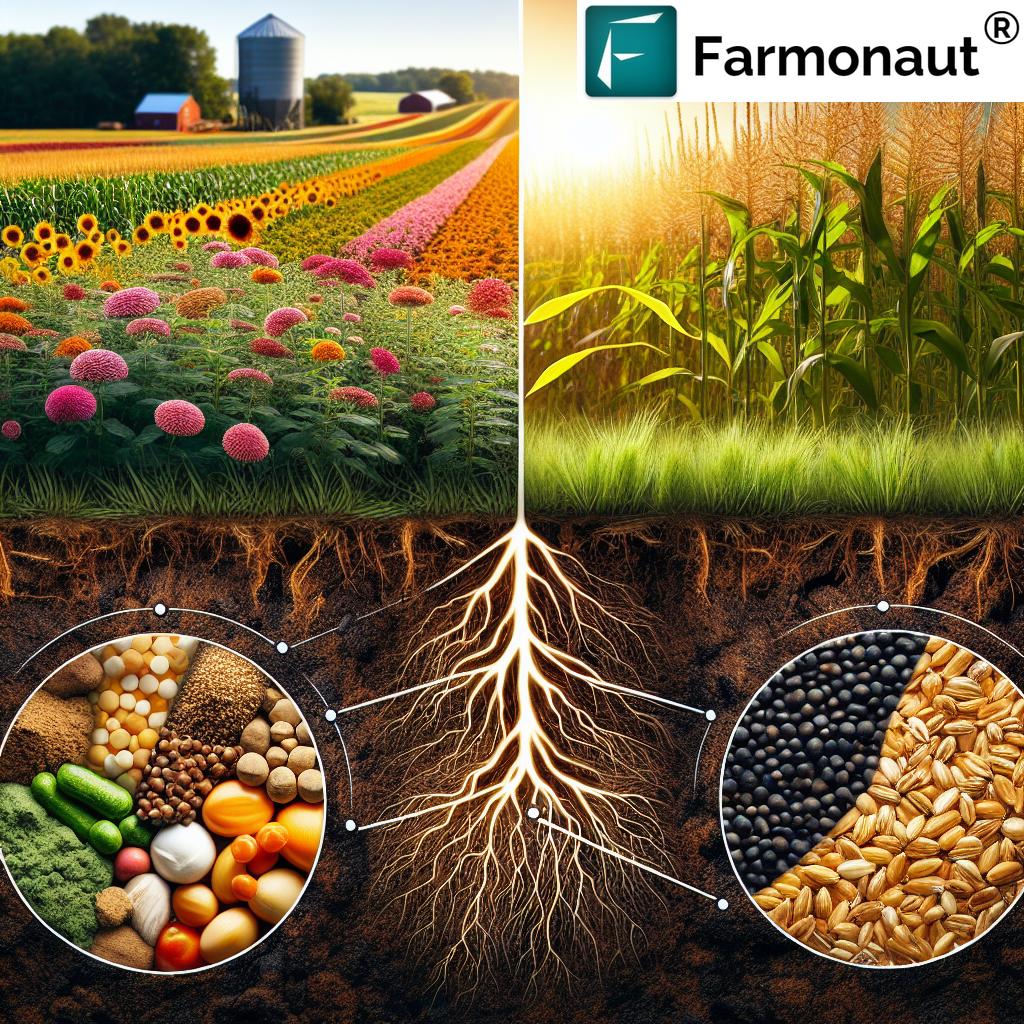Uncovering Colonial Legacy: The Three Chimneys Historical Site in Ormond Beach, Florida’s Oldest Sugar Mill and Rum Distillery
“The Three Chimneys historical site in Ormond Beach, Florida, dates back to the 18th century, making it over 200 years old.”
Welcome to a journey through time as we explore the fascinating Three Chimneys historical site in Ormond Beach, Florida. This remarkable attraction stands as a testament to America’s colonial past and industrial heritage, offering visitors a unique glimpse into the early days of sugar production and rum distillation in the United States.
As we delve into the rich history of this site, we’ll uncover the intricate processes of sugar cane cultivation, the innovative technologies employed in the 18th century, and the complex socio-economic dynamics that shaped this era. Join us as we peel back the layers of time to reveal the stories etched in the very soil of this historic sugar mill and rum distillery.
The Origins of Three Chimneys: A Journey to Colonial Florida
Long before Ormond Beach became known as the “Birthplace of Speed” in the early 1900s, this area was home to a thriving Native American population and later became the site of extensive sugar cane plantations. The Three Chimneys historical site, nestled just off the bustling Granada Boulevard, stands as a silent witness to this bygone era.

Around 1765, during the period of British control in Florida, King George III issued a decree that would shape the destiny of this land. He ordered that 20,000 acres be dedicated to the production of sugar, molasses, and rum using slave labor. This royal mandate set the stage for the establishment of what would become the oldest sugar mill and rum distillery in the United States.
The Three Chimneys site, predating even the Declaration of Independence, offers us a unique window into Florida’s colonial past. It stands as the only remaining intact British colonial structure in the area, serving as a tangible link to the European development and industrial activity that would come to define this region.
The Agricultural Legacy of Ormond Beach
To truly appreciate the significance of the Three Chimneys site, we must first understand the agricultural context of the area. Dr. Philip Shapiro of the Ormond Beach Historical Society provides valuable insights into the region’s farming history:
“Agriculture has been present in this area for over a thousand years, thanks to the consistently damp ground, once known as ‘swamp settlement’.”
This rich, moist soil created ideal conditions for cultivation, particularly for crops like sugar cane that thrive in warm, humid environments. The natural advantages of the land, combined with the colonial ambitions of the British Empire, set the stage for the development of a thriving sugar industry in Florida.
The Industrial Marvel: Sugar Production at Three Chimneys
At the heart of the Three Chimneys site lies an impressive feat of 18th-century industrial engineering. The sugar mill was a complex operation, employing cutting-edge technology of its time to process sugar cane into valuable commodities.
The Boiling House: Heart of the Sugar Mill
The site originally housed four boiling vats, which were crucial for processing sugar cane. These vats were the centerpiece of the operation, where the magic of transforming raw cane juice into sugar and molasses took place.
The Power of Oxen: Driving the Crushing Machines
Dr. Shapiro paints a vivid picture of the mill’s operation:
“Oxen powered the crushing machines, feeding sugar cane juice into the vats.”
This use of animal power was typical of the era, providing the necessary force to extract the precious juice from the tough sugar cane stalks.
British Engineering: The Iron Flues
One of the most intriguing aspects of the Three Chimneys site is the presence of iron flues manufactured in England. Due to colonial restrictions on local manufacturing, these essential components had to be imported from across the Atlantic. These flues played a vital role in the sugar-making process, channeling heat to the boiling vats.
The Art of Sugar Making
The process of sugar production was a delicate art, requiring skill and precision. Workers would heat the cane juice, carefully transferring it through successive vats to produce molasses. This labor-intensive process required constant attention and expertise to achieve the desired product.
The Rum Distillery: A Profitable Venture
Adjacent to the sugar mill stood the rum distillery, a testament to the ingenuity of colonial entrepreneurs who sought to maximize the value of their sugar cane crop. The distillery featured two vats and a single chimney, a setup that proved to be highly profitable.
Historical records indicate that by 1772, the distillery was already a lucrative operation. This success underscores the economic importance of rum production in colonial America, where the spirit was not only a popular beverage but also a valuable trade commodity.
The Mystery of the Name
Interestingly, the origin of the name “Three Chimneys” remains shrouded in mystery. Despite the site’s historical significance, documentation from that era is sparse, leaving us to speculate about the reasoning behind this intriguing moniker.
This enigma adds an extra layer of fascination to the site, inviting visitors to ponder the possible explanations and encouraging further historical research.
The Human Cost: Labor and Slavery at Three Chimneys
While we marvel at the industrial achievements of the Three Chimneys site, it’s crucial to acknowledge the human cost of this operation. Historical documents suggest that at least 50 enslaved workers were present at any given time, highlighting the harsh realities of colonial-era labor practices.
These individuals, torn from their homes and forced into grueling labor, were the unsung heroes behind the site’s productivity. Their stories, though often overlooked in historical narratives, are an integral part of the Three Chimneys legacy.
Preserving the Past: Three Chimneys Today
Today, the Three Chimneys historical site stands as a protected landmark, offering visitors a chance to step back in time and experience a crucial chapter in Florida’s colonial history. The preserved ruins and informative displays provide a tangible connection to the past, allowing us to better understand the complexities of early American industry and society.

“As Florida’s oldest sugar mill and rum distillery, the Three Chimneys site represents a significant part of America’s 300+ year industrial heritage.”
The Significance of Three Chimneys in American History
The Three Chimneys historical site is more than just a local attraction; it’s a vital piece of America’s industrial and colonial heritage. Its significance extends far beyond the borders of Ormond Beach, offering insights into:
- Early American manufacturing techniques
- The economic foundations of colonial society
- The complex relationship between agriculture, industry, and labor in pre-revolutionary America
- The role of British colonial policy in shaping the American landscape
By preserving and studying sites like Three Chimneys, we gain a more nuanced understanding of the forces that shaped our nation in its infancy.
Technological Innovations at Three Chimneys
The Three Chimneys site showcases several technological innovations that were cutting-edge for their time. These advancements in sugar processing technology played a crucial role in increasing efficiency and output:
1. Improved Crushing Machines
The ox-powered crushing machines used at Three Chimneys represented an improvement over earlier manual methods, allowing for greater juice extraction from sugar cane.
2. Advanced Boiling Systems
The four-vat boiling system allowed for a more controlled and efficient sugar-making process, improving both the quality and quantity of the final product.
3. Imported Iron Flues
The use of iron flues imported from England demonstrated the site’s access to advanced materials and engineering, enhancing the heat distribution in the boiling process.
4. Integrated Rum Distillery
The addition of a rum distillery to the sugar mill complex showcased an early example of vertical integration in colonial industry, maximizing the value of the sugar cane crop.
These technological advancements at Three Chimneys reflect the broader trends of innovation and industrialization that were beginning to transform the American colonies in the late 18th century.
The Environmental Impact of Colonial Sugar Production
While the Three Chimneys site represents a significant historical achievement, it’s also important to consider its environmental impact. The establishment of sugar cane plantations in Florida had profound effects on the local ecosystem:
- Deforestation: Large areas of native vegetation were cleared to make way for sugar cane fields.
- Soil Depletion: The intensive cultivation of sugar cane could lead to soil exhaustion over time.
- Water Usage: Sugar cane is a water-intensive crop, potentially straining local water resources.
- Waste Production: The sugar-making and rum distillation processes produced waste products that could impact local waterways.
Understanding these environmental aspects adds another layer to our appreciation of the site’s historical significance and prompts reflection on the long-term consequences of colonial-era agricultural practices.
Three Chimneys in the Context of Colonial Trade Networks
The Three Chimneys sugar mill and rum distillery didn’t exist in isolation. It was part of a vast network of colonial trade that spanned the Atlantic world. The products produced at this site – sugar, molasses, and rum – were valuable commodities in the triangular trade between Europe, Africa, and the Americas.
Here’s how Three Chimneys fit into this larger economic picture:
- Raw Materials: Sugar cane was cultivated using enslaved labor from Africa.
- Production: The cane was processed into sugar and molasses at sites like Three Chimneys.
- Distillation: Some of the molasses was further refined into rum at the on-site distillery.
- Export: These products were then shipped to markets in Europe and other American colonies.
- Trade: The profits from these exports were often used to purchase more enslaved people and other goods, perpetuating the cycle.
Understanding this context helps us appreciate the global economic forces that drove the development of sites like Three Chimneys and their role in shaping the colonial world.
Visiting Three Chimneys: A Journey Through Time
For those interested in experiencing this piece of American history firsthand, visiting the Three Chimneys historical site offers a unique opportunity to step back in time. Here’s what visitors can expect:
- Guided Tours: Knowledgeable guides offer insights into the site’s history and operations.
- Preserved Ruins: The remaining structures provide a tangible link to the past.
- Interpretive Displays: Informative exhibits help visitors understand the sugar-making process and the site’s historical context.
- Natural Beauty: The surrounding landscape offers a glimpse of Florida’s natural environment.
Visiting Three Chimneys is not just an educational experience; it’s a journey through a crucial period in American history, offering insights into the industrial, economic, and social forces that shaped our nation.
The Legacy of Three Chimneys: Reflections on Colonial History
As we conclude our exploration of the Three Chimneys historical site, it’s important to reflect on its broader significance and the lessons it offers for contemporary society:
- Technological Progress: The site showcases early American ingenuity and the roots of industrial development.
- Economic Foundations: It provides insights into the economic systems that underpinned colonial society.
- Labor History: The site prompts important discussions about the role of enslaved labor in building American wealth.
- Environmental Impact: It offers a historical perspective on human-environment interactions and agricultural practices.
- Cultural Heritage: Three Chimneys represents a tangible link to our past, helping us understand our national identity.
By studying and preserving sites like Three Chimneys, we gain a more nuanced understanding of our history, both its achievements and its darker aspects. This knowledge empowers us to make more informed decisions about our present and future.
Comparative Timeline of Three Chimneys Historical Site
| Year/Period | Event/Development | Significance |
|---|---|---|
| Pre-colonial era | Native American presence | Indigenous cultivation and use of land |
| 1760s | Establishment of sugar mill and rum distillery | Beginning of colonial industrial activity in the area |
| 1770s | Peak production period | Height of sugar and rum production, economic prosperity |
| 1780s | Decline of operations | Shift in colonial policies, changing economic conditions |
| 19th century | Site abandonment | End of industrial activity, site falls into disrepair |
| 20th century | Rediscovery and archaeological studies | Recognition of historical significance, preservation efforts begin |
| Present day | Preservation and tourism | Educational resource, tourist attraction, historical landmark |
FAQs About the Three Chimneys Historical Site
Q: When was the Three Chimneys site established?
A: The Three Chimneys sugar mill and rum distillery were established around 1765 during the British colonial period in Florida.
Q: Why is it called “Three Chimneys”?
A: The exact origin of the name is unclear due to limited historical documentation. It may refer to prominent structures on the site, but this remains a subject of historical inquiry.
Q: What was produced at the Three Chimneys site?
A: The site primarily produced sugar, molasses, and rum from sugar cane grown in the surrounding plantations.
Q: How long was the site operational?
A: The site was most active from the 1760s through the 1780s, with peak production in the 1770s.
Q: Can visitors tour the Three Chimneys site today?
A: Yes, the site is preserved as a historical attraction and is open to visitors. Guided tours are available to explore the ruins and learn about the site’s history.
Conclusion: The Enduring Significance of Three Chimneys
The Three Chimneys historical site in Ormond Beach, Florida, stands as a powerful reminder of our nation’s complex past. As the oldest sugar mill and rum distillery in the United States, it offers a unique window into the industrial, economic, and social dynamics of colonial America.
From the innovative sugar processing technology to the profitable rum distillation, from the toil of enslaved workers to the environmental impacts of plantation agriculture, Three Chimneys encapsulates the multifaceted nature of our historical legacy.
As we continue to grapple with issues of economic development, labor rights, and environmental sustainability in the modern era, sites like Three Chimneys offer valuable lessons and perspectives. They remind us of the ingenuity of our forebears while also prompting critical reflections on the human and environmental costs of progress.
By preserving and studying these historical sites, we not only honor our past but also gain insights that can guide us toward a more just and sustainable future. The Three Chimneys site, with its silent chimneys and weathered ruins, continues to speak volumes about who we were, who we are, and who we aspire to be as a nation.
As we reflect on the historical significance of sites like Three Chimneys, it’s worth considering how modern technology can help us better understand and manage our agricultural heritage. While colonial sugar production relied on manual labor and basic machinery, today’s farmers have access to advanced tools for crop monitoring and management.
Farmonaut is at the forefront of this agricultural revolution, offering satellite-based farm management solutions that can help modern farmers optimize their crop yields while minimizing environmental impact. While not directly related to historical sites like Three Chimneys, Farmonaut’s technology represents the continued evolution of agricultural practices.
For those interested in exploring how modern technology is shaping the future of agriculture, you can learn more about Farmonaut’s services:
While we honor our agricultural heritage through sites like Three Chimneys, innovative solutions like those offered by Farmonaut are helping to write the next chapter in the story of American agriculture.
Earn With Farmonaut: Affiliate Program
Earn 20% recurring commission with Farmonaut’s affiliate program by sharing your promo code and helping farmers save 10%. Onboard 10 Elite farmers monthly to earn a minimum of $148,000 annually—start now and grow your income!
As we continue to learn from our past and innovate for the future, let’s remember that the story of American agriculture is one of constant evolution, from the sugar mills of colonial Florida to the satellite-guided farms of today.













